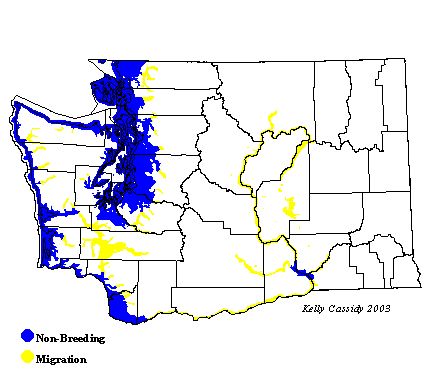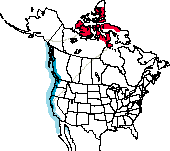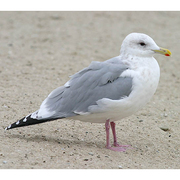Thayer's Gull
The Washington representatives of this family can be split into two groups, or subfamilies. The adaptable gulls are the most familiar. Sociable in all seasons, they are mainly coastal, but a number of species also nest inland. Many—but not all—are found around people. Gulls have highly variable foraging techniques and diets. Terns forage in flight, swooping to catch fish or insects. They dive headfirst into the water for fish. Although they are likely to be near water, they spend less time swimming than gulls.
General Description
The Thayer's Gull is a large gull, with typical gull-like plumage. Until 1972, it was considered a subspecies of Herring Gull, but is once again classified as a full species. The adult is solid slate-gray on its backs and wings, with black on the outer edges of the wings. The undersides of the wings are pale. The trailing edge of the wing is white, and the legs are pink. White in the breeding season, its head is brown and dirty-looking in the non-breeding season. Immature birds sport a variety of plumages with varying degrees of mottled brown and white mixed with adult plumage characteristics. Thayer's Gulls mature in four years.
Habitat
During the breeding season, Thayer's Gulls inhabit the Canadian high Arctic, nesting on rocky coastlines of islands. In winter, they can be found around bodies of water near the coast, including estuaries and protected bays. They also spend time far offshore, on freshwater ponds, and garbage dumps near the coast.
Behavior
Thayer's Gulls forage while swimming, walking, or flying. When foraging in flight, they drop to the water's surface or plunge just below it.
Diet
Omnivores, Thayer's Gulls eat small fish, crustaceans, mollusks, carrion, eggs, young birds, and garbage.
Nesting
The breeding characteristics of the Thayer's Gull are not well known. They probably start breeding at four years of age. Typical of gulls, they nest in colonies, often mixed with other gull species. The nest is located on the ledge of a rocky island cliff. Both sexes help build the nest, which is a low mound of plant material, matted down in the middle. The female usually lays 2, or occasionally 3, eggs, and both sexes help incubate the eggs and feed the young. Incubation and fledging periods are not known.
Migration Status
Most Thayer's Gulls nest in the central Canadian Arctic and move southwest to the Pacific coast in winter. The main migration of Thayer's Gulls through Washington in the fall occurs in September, with wintering numbers peaking in December and January. Washington and southern British Columbia are the core of their winter range. They begin leaving for their Arctic breeding grounds in late March, and by May, most are gone from our area.
Conservation Status
The nesting range of the Thayer's Gull has been protected from human impact due to its remoteness. No obvious population trends have been observed although more study is needed. There is still debate about whether the Thayer's Gull is truly a separate species, or if it is a subspecies of Iceland Gull. Some estimates have placed the breeding population at 8,000-12,000 birds, while others claim it is much greater, underestimated due to misidentification.
When and Where to Find in Washington
Thayer's Gulls are regular migrants and winter residents in Washington from October to March in offshore, coastal, and the Puget Trough regions. They are uncommon in April and early May, and are usually absent from mid-May until September. In winter, they can also be seen around the lower Columbia River and the Willamette Valley. The Port of Tacoma area and Ediz Hook at Port Angeles are excellent places to look for Thayer's Gulls. Agricultural areas and garbage dumps are good inland spots to look for them. In late February and early March, hundreds are attracted to the smelt runs on the lower Columbia River.
 Abundance
Abundance
| Ecoregion | Jan | Feb | Mar | Apr | May | Jun | Jul | Aug | Sep | Oct | Nov | Dec |
|---|---|---|---|---|---|---|---|---|---|---|---|---|
| Oceanic | U | U | U | U | U | U | U | |||||
| Pacific Northwest Coast | U | U | U | U | R | U | U | U | ||||
| Puget Trough | F | F | F | U | R | R | U | U | F | |||
| North Cascades | ||||||||||||
| West Cascades | R | R | R | R | ||||||||
| East Cascades | R | R | ||||||||||
| Okanogan | ||||||||||||
| Canadian Rockies | ||||||||||||
| Blue Mountains | ||||||||||||
| Columbia Plateau | R | R | R | R |
Washington Range Map

North American Range Map


Family Members
 Laughing GullLarus atricilla
Laughing GullLarus atricilla Franklin's GullLarus pipixcan
Franklin's GullLarus pipixcan Little GullLarus minutus
Little GullLarus minutus Black-headed GullLarus ridibundus
Black-headed GullLarus ridibundus Bonaparte's GullLarus philadelphia
Bonaparte's GullLarus philadelphia Heermann's GullLarus heermanni
Heermann's GullLarus heermanni Black-tailed GullLarus crassirostris
Black-tailed GullLarus crassirostris Short-billed GullLarus canus
Short-billed GullLarus canus Ring-billed GullLarus delawarensis
Ring-billed GullLarus delawarensis California GullLarus californicus
California GullLarus californicus Herring GullLarus argentatus
Herring GullLarus argentatus Thayer's GullLarus thayeri
Thayer's GullLarus thayeri Iceland GullLarus glaucoides
Iceland GullLarus glaucoides Lesser Black-backed GullLarus fuscus
Lesser Black-backed GullLarus fuscus Slaty-backed GullLarus schistisagus
Slaty-backed GullLarus schistisagus Western GullLarus occidentalis
Western GullLarus occidentalis Glaucous-winged GullLarus glaucescens
Glaucous-winged GullLarus glaucescens Glaucous GullLarus hyperboreus
Glaucous GullLarus hyperboreus Great Black-backed GullLarus marinus
Great Black-backed GullLarus marinus Sabine's GullXema sabini
Sabine's GullXema sabini Black-legged KittiwakeRissa tridactyla
Black-legged KittiwakeRissa tridactyla Red-legged KittiwakeRissa brevirostris
Red-legged KittiwakeRissa brevirostris Ross's GullRhodostethia rosea
Ross's GullRhodostethia rosea Ivory GullPagophila eburnea
Ivory GullPagophila eburnea Least TernSternula antillarum
Least TernSternula antillarum Caspian TernHydroprogne caspia
Caspian TernHydroprogne caspia Black TernChlidonias niger
Black TernChlidonias niger Common TernSterna hirundo
Common TernSterna hirundo Arctic TernSterna paradisaea
Arctic TernSterna paradisaea Forster's TernSterna forsteri
Forster's TernSterna forsteri Elegant TernThalasseus elegans
Elegant TernThalasseus elegans

